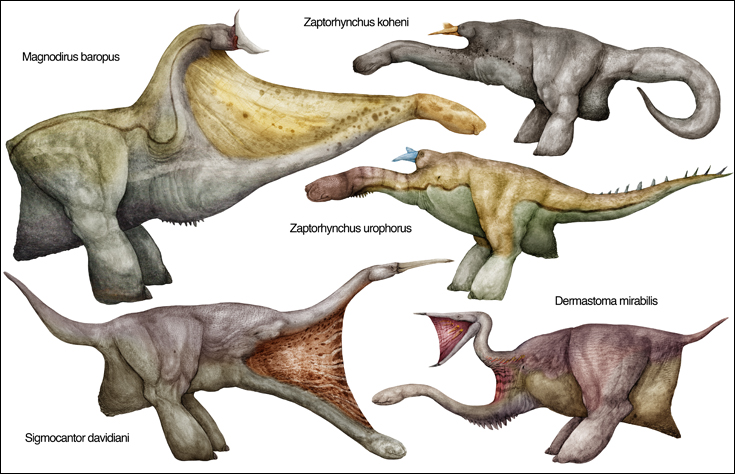Titaniformes
This group of unusual bipeds dominates the herbivorous niches in the island continent of Thalassia. Fossil records indicate that the Titaniformes evolved in the last thirty-five million years. They are tentatively classified as relatives of equally weird Thalassian clades like Monoanticherans and Tromobrachids on the basis of shared characteristics such as leathery eggs and singular toes on their rear feet. Whereas an herbivorous lifestyle means the extension of the second-head gut into the abdominal cavity of many other plant-eating lineages, the Titaniformes accommodate the extended digestive system directly in their second-head “necks,” essentially carrying their guts in front of their bodies. This has led to the development of unusual body plans and support mechanisms in many Titaniform clades, culminating in the rigid, test-like bodies and crane-like double neck systems of the legendary Magnodires. In all forms, the rear part of the body is pretty much free from digestive organs (the exception being a thin canal leading to the anus,) and instead houses a massively strengthened hydraulic system that supports these animals’ hulking bodies. In smaller forms, this translates into an impressive jumping capability.
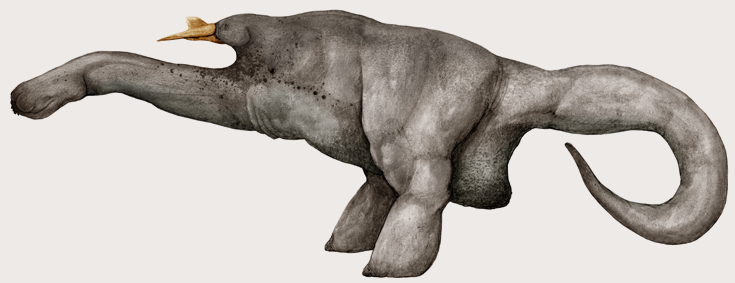
Species: Zaptorhynchus koheni
Common Name: Black skip-bird, Skip-bird.
Size: 1.8 meters long, including tail.
Habitat: Montane scrubland and forests in South-Eastern Thalassia.
Alongside the Monoanticheran Pistonopodid Bounderjaws, the egg-shaped, long-tailed Oozoan skipbirds such as Zaptorhynchus are the most common and readily recognizable herbivores in all of Thalassia. There are over sixty species of such animals in Thalassia, each adapted to a particular region. Most Oozoans are small, usually not much heavier than a fully-grown person. Their small sizes give these animals an evolutionary edge; two-thirds of all Titaniform species in Thalassia are Oozoans.
Living in the hills and low, misty mountain forests of the island continent, Z. koheni is a timid, easily scared herbivore that will run away at the slightest disturbance. Its rear body houses an exaggerated system of hydraulic pumps and vessels, not as developed as some of the other Titaniformes’, but far more extensive than that of a comparably sized animal from the mainland continents. These adaptations allow Z. koheni, not to mention similar Oozoans, achieve the startling, spasmodic leaps that earn them the name, “skipbirds.”
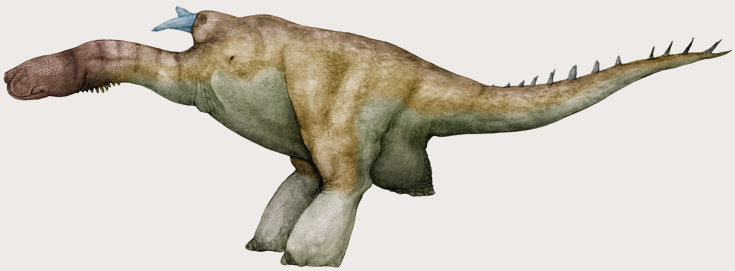
Species: Zaptorhynchus urophorus
Common Name: Spiketailed Skipbird, Giant Skipbird.
Size: 6 meters long, including tail.
Habitat: Plains and sprogland across Thalassia.
At six meters long, there is nothing “skippy” about Z. urophorus, the largest of its genus and indeed, of all Oozoan Titaniformes. These ponderous beasts roam the Thalassian plains in family groups of five or three, grinding down all sorts of local vegetation with their well developed, munching second heads. They are well-protected from the attentions of Tromobrachids and Volugnaths by their powerful tails, a swing of which can easily drive foot-long spikes through the arm-jaws of any attacker.

Species: Dermastoma mirabilis
Common Name: Flagmouth, Flagger.
Size: 2 meters long, usually less.
Habitat: Thalassian jungles.
The exclusive use of their second heads for feeding has freed up the Titaniforme first head for sexual displays, and given rise to a number of spectacularly adorned forms throughout their evolution. Among the strangest of those are the those of Dermastoma; a rare genus of forest-dwelling Titaniformes with rigid, cauldron-like bodies and in the males, flap-like genitals that stretch across their first heads. These animals range across the forest floor, digging and foraging with their hose-like second heads for fruits, succulent plants and the occasional small animal. In the mating season males develop elaborate, colorful flaps across their first-head jaws, and promptly enter a season of vicious flag-tearing fights and seductive head-bobbing displays. Competing males try to tear each other’s flags while trying to impress females at the same time. The females, on the other hand, prefer the males with the brightest and least tarnished genital flags. After the mating season is over, the males’ flags fall off by themselves and the forest floor goes quiet once again.
The three species of Dermastomes are classified with the legendary Magnodires and related forms as Eudiran Titanoformes, which are distinct from the Oozoan Titaniformes discussed earlier.
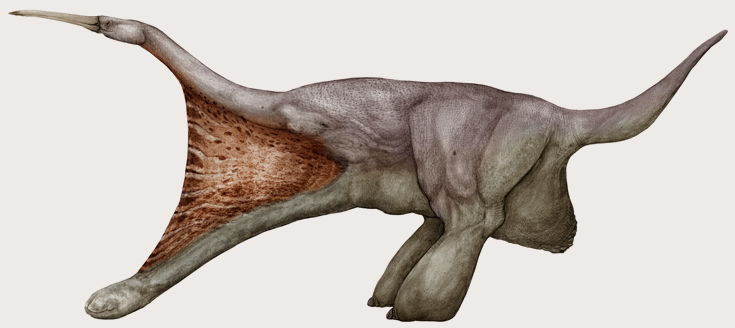
Species: Sigmocantor davidiani
Common Name: Singing Flagger.
Size: 3-5 meters long.
Habitat: Sprogland and the edges of forests across Southern Thalassia.
This large Magnodiran Titaniform also bears a conspicuous flap of skin, although unlike its Dermastoman cousins, the display flaps of these animals lie between their two heads, are not shed in the mating season and are shared by both sexes.
With its elongated, stork-like beak mainly used for preening its spectacular skin-sail, this animal is a fairly typical, medium-sized Magnodire. Members of this species lead solitary lives, sometimes communicating with their distant neighbors with unusually melodic songs that reverberate across the bluish-grey sprog plains of Southern Thalassia. Research is underway to determine the true purpose of these songs, and whether they convey any meaningful signals from one animal to another. For the citizens of Snaiad, on the other hand, these animals’ eerie, stereo songs form an indispensable part of the “alien world within an alien world” image of Thalassia.
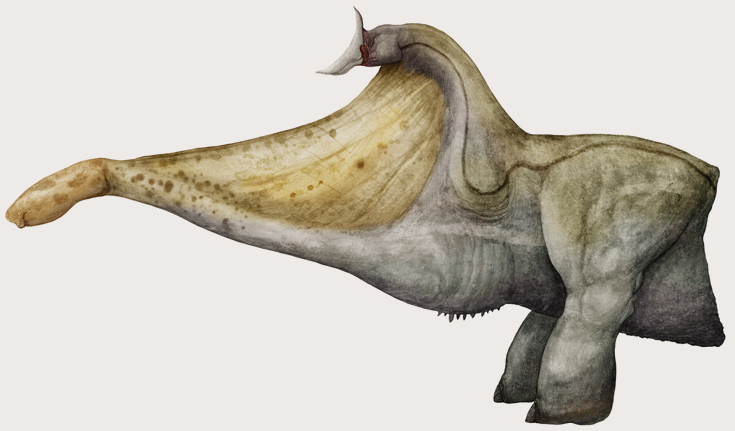
Species: Magnodirus baropus
Common Name: Legendary Magnodire, Titan.
Size: Up to 12 meters long including second-head neck.
Habitat: Sproglands and plains all across Thalassia.
This is the “Legendary Magnodire,” the largest land animal on Thalassia and an iconic symbol of the continent. When first seen, these animals were nicknamed “Titans,” which led to the use of the name Titaniformes for the entire group. In this form, the long second head present on all Titaniformes has been super-extended into a very long, drawbridge-like structure. The inter-head sail, used for display in all related forms, has assumed the secondary purpose of structural support with strengthened tendons running across its length. The body, too has been modified, with a rigid ventral skid and thickened backbone providing support for the impressive feeding equipment up front. The tail, unlike all other Titaniformes, has been completely reduced.
These gigantic animals spend their day sitting on their rear skids, grazing across a large circle twice as wide as their second-head necks. They are also perfectly capable of walking long distances, and even running when faced with attacks from large predators such as See-rexes.
Copyright laws protect all intellectual property associated with Snaiad.
All artwork, concepts and names associated with this project belong to C. M. Kosemen, unless otherwise stated.
